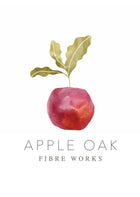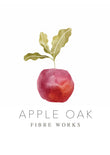

100 % Natural Indigo | Origin: India | No synthetic additives
Harvested and processed in southern India, this true indigo powder delivers the deep, cool blues prized by dyers for centuries. Because indigo is an insoluble pigment (not a dye that bonds with a mordant), no mordant is required—just a reduced (oxygen-free) vat.
Why choose our indigo?
• Authentic & plant-based – Derived solely from Indigofera tinctoria leaves; never synthetic.
• Economical – ≈ 50 g colours 3–4 kg of wool to a strong mid-blue.
• Low-energy process – Vats work at 30 – 40 °C; no hard boiling.
• Versatile methods – Suitable for any indigo vat, be it fructose, mineral or bran-ferment vats, yeast vats, sig vats or quick hydros vats.
• Excellent colour-fastness – Outstanding on deeper shades, good on lighter blues.
Typical yield
• Pale sky blue – 1 g per 100 g fibre
• Medium denim – 5 g per 100 g fibre
• Deep navy – 12 g + per 100 g fibre (multiple dips)
Quick-start options
• Organic Sugar Vat – Indigo + lime + fructose (no fermentation wait).
• Yeast Fermentation Vat – Gentle, long-lasting; see recipe below.
• Hydros Vat – Fast one-hour reduction (includes chemical oxygen remover).
Yeast Vat Recipe (500 g fibre)
9 l water · 110 g sugar · 50 g preservative-free dried yeast
30 g bicarbonate of soda · 40 g indigo (ground)
• Maintain 40 °C (not above 50 °C).
• Reduce for 48 h until liquid turns yellow-green with a copper sheen.
• Dip pre-wetted, unmordanted fibre; oxidise 60 min; repeat for depth.
Storage & safety
Store in a cool, dry place, sealed against moisture. Wear a mask when handling fine pigment and gloves when working with lime, hydros or iron additives. Dispose of spent vats responsibly.
Looking for a complete setup? Our Indigo Sugar Vat Kit and Hydros Vat Kit include all auxiliaries, plus step-by-step instructions.
Logwood Dye
Dye Colour: Blue, Purple & Black | Collected in the Wild in Haiti
Logwood (Haematoxylum campechianum), also known as Bois de Campeche or Campeachy Wood, is a natural, pH-sensitive dye that originates from wood found in Central America. This versatile dye creates stunning blues, purples, and deep blacks on wool, cotton, and silk. While its colour fastness is considered poor by experienced dyers, Logwood is commonly used in combination with other dyes to achieve rich, deep blacks. Perfect for eco-conscious artists, Logwood is available as cut or ground bark for your dyeing projects.
Colour Fastness: Poor (best used with other dyes for black)
Product Details:
Basic Recipe (Using Ground Bark):
Ingredients:
Instructions:
Alternatively, soak the Logwood chips overnight, then boil for 1 hour before use.
For Logwood extract, please visit our Natural Dye Extracts Page.
Explore the potential of Logwood Dye for a range of vibrant blues, purples, and blacks in your natural dyeing projects!
Black Mallow Rose Flowers (Hollyhock)
Latin: Malvae arbor. Flor. tot. | Botanical: Alcea rosea L.
These vibrant Black Mallow Rose Flowers, also known as Hollyhocks, are perfect for eco-printing and natural dyeing projects. When used in eco-printing, they create stunning purple-blue to violet hues on fabric, with the rich tones evolving beautifully over time. Their colour fastness ranges from weak to medium, but can be enhanced with the proper mordants.
Eco-Printing Tips:
Durability:
Black Mallow Rose prints can retain their colours for years, but that very much depends on light exposure and washing. The anthocyanins in the petals provide some longevity, though fading may occur with prolonged sunlight or frequent washing.
Join The Natural Dyers & Growers Academy to share your experiences and get support from fellow growers.
Dyer's Broom cut
This product, DYER'S BROOM ~ cut, is traditionally utilized for dyeing yellow and green shades. The resulting green hue tends to lean more towards a tan colour.
Colour fastness: medium
Basic recipe:
100% Broom
10% Alum
3% Iron as green option
Mordant as required, extract broom in 85C degrees Celsius for 1h. Remove dye, switch off pot and add your item and leave overnight. Treat with iron as an after mordant. Rinse, wash.
Colour fastness: medium
We’re not fans of crowded inboxes either, so here’s what you can look forward to in our newsletters:
✨ Updates from the Academy – new workshops, courses, and events
🧶 News from the Dye House – behind-the-scenes, fibre stories, and inspiration
🛍 Shop highlights – fresh arrivals, special offers, and exclusive sales
And of course, you’re always in control — unsubscribe anytime with a single click at the bottom of any email.
As a little welcome gift, enjoy 5% off your first order in our webshop with the code WELCOMEPOP.
Happy making! 🌿







